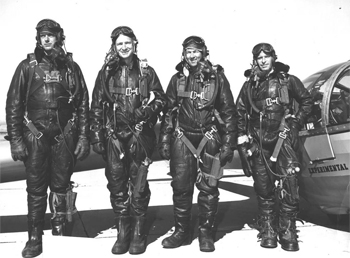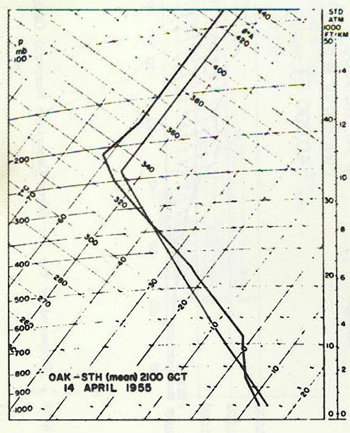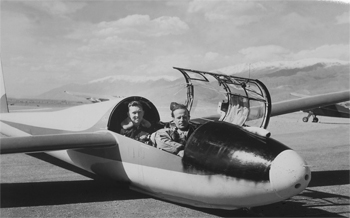High Altitude Record Flight of Joachim Küttner on Apr 14th, 1955 *
* Excerpt of the lecture: Heise, R. (2007): High Altitude flights about the ACONCAGUA - a MWP exploration into the stratosphere, 66. Deutscher Segelfliegertag, Messezentrum Sinsheim
Pilot Report
If you plan prolonged flights at levels near 40,000 ft, you must be prepared to encounter some hazardous conditions, due to very low temperatures ( –60°C to -70°C) and very high wind speeds (near 200 km/hr) in the jetstream regime.
Fig. 1: Cloud picture of the mountain wave of 14 April 1955. Note rotor clouds beneath wave clouds. Cirrus bands near horizon indicate jetstream. Wind from right to left.
During April and May in 1955, we had unusually frequent mountain wave events. Of the 14 glider research flights, seven exceeded the 40,000 ft level, with temperatures near -70 °C. (In the wave updrafts, temperatures are especially low due to adiabatic cooling.)
On the record day of 14 April 1955, three hours were spent close these “super-cooled” levels, resulting in some serious malfunctions and difficult decision-making episodes.
Fig.2: Temperature sounding of 14 April 1955, upwind of Sierra Nevada (Sta Maria and Oakland).
Our well tested oxygen system failed first, and in an unexpected way. At about 40,000 ft, one had to switch from 100% to “pressure oxygen”. When exhaling, one had to overcome this added pressure through an “exhalation valve”. This valve began to freeze up and to block the exhale capability. To restore it, one had to briefly lift up the oxygen mask at each exhalation effort, and to restore it quickly for the breathing cycle. Clearly, this was a risky and unreliable procedure.
We were now flying in the stratosphere and rapid descent to safe levels was indicated. This was supposed to be the task of the spoilers. However, the spoilers turned out to be frozen, also, and could not be moved, even with strong muscle-effort. The strange situation developed of being caught in the updraft area and unable to descend. Slowly the weak wave updraft carried the ship higher in the jetstream.
Fig. 3: Wind sounding of 14 April 1955, about 100 km upwind of Sierra Nevada
It was now conceivable to increase the rate of descent by raising the airspeed. However, at this altitude such a maneuver may bring you close to “flutter speed”.
The flutter problem had been familiar to me from the last year of WWII, when I survived the flutter crash of the six-motor “ Messerschmidt Gigant ” with a “Leitwork loss” at 7000 m and a 6000 m freefall (by the way, at Heuberg). In other words, descent by “drücken” at the jetstream level was not advisable. To try other maneuvers such as spin or sideslip seemed at little too experimental at this altitude and in the presence of serious oxygen problems.
There was, however, the possibility of locating a natural downdraft area. Upwind and downwind of the present wave updraft area, organized wave downdraft areas should be located. For the reasons just described, the downwind area was preferred. It could be reached quickly by flying slowly downstream (eastward) in the jetstream, and returning upstream (westward) in the weaker low-level winds. Happy landings in Bishop occurred after about four hours.
The aircraft used was a newly designed Schweizer 2-25, two-seater, flown single-seated because of the instrument load (see Fig. 4).
Fig. 4: Schweizer 2-25 sailplane. Rear seat: Harold Klieforth. Front seat: Joachim Kuettner
A new world altitude record was expected until it was learned that a 5% increment was required by the FAI. After this flight the increment was changed by – I think – 200 m. The national (German) record was not affected.
Joachim Kuettner
" Liebe Deutsche Segelflug - Freunde,
leider kann ich diesmal nicht unter Euch weilen, weil ich mein rechtes "Fahrgestell" gebrochen habe. Aber ich will es nächstes Jahr wieder versuchen.
Man sagt hier in USA manchmal: "Rekorde"haben den Zweck,gebrochen zu werden". Aber muss man dazu ein halbes Jahrhundert warten?
(Natuerlich wäre ein solcher Versuch nicht vergleichbar mit Fossetts und Einar's so sorgfaelltig konstruiertem und geplanten Projekt, von dem ich hoffe, dass es nicht aufgegeben wird.)
Hier kommt eine interessante Frage:
"Was bedeutet denn ein "Rekord?
Dass man eine höhere " Zahl " erreicht hat als irgend jemand vor einem?
Es kann auch etwas ganz anderes bedeuten, wie René euch erzählen wird,
nämlich dass man eine neue Welt erlebt hat (in diesem Fall die Stratosphäre selbst) ,die einen aber in ihrem Inneren gefangen halten kann, als sei man ein Eindringling.
Und nun wünsche ich Euch eine interessante Tagung und vielleicht auf Wiedersehen im nächsten Jahr.
Euer Joachim "
Additional Informations
-
Celebration of a Renaissance Man: The Joachim Kuettner Symposium
-
Deutscher Aeroclub - Ein Pionier und VisionAer wird 100 Jahre alt
-
WMO-Bulletin 1989 - An Interview with Joachim P.Kuettner
-
National Records (Germany) - High Altitude Record

 Fig. 5: Pilots suited up for the Sierra Wave Jetstream Project
Fig. 5: Pilots suited up for the Sierra Wave Jetstream Project











